- 8 Minutes to read
- Print
- DarkLight
- PDF
1.7 Modeling Release Notes, May
- 8 Minutes to read
- Print
- DarkLight
- PDF
The following table provides an overview of features and enhancements in this release.
| Feature | SpotlightXL | Spotlight |
|---|---|---|
X | X | |
X |
| |
X |
| |
X |
| |
X |
| |
Integration with Planning, Consolidation, or Reporting Applications | X | X |
X | X | |
Support for Multiple Rows in Formula Scope When Defining the Formula | X |
|
X |
| |
X |
| |
X |
| |
X |
|
New Zoom In Options
We’ve added new options to the Zoom In action. Now, you can zoom in to all levels of a dimension hierarchy or the next level within the hierarchy. An image of Zoom in and new options is shown below.
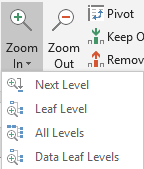
All Level
Select the Analyze task and the Data subtask. Select a dimension and then click the Zoom in list-box and select All Level.
In the example below, the Time dimension is displayed.
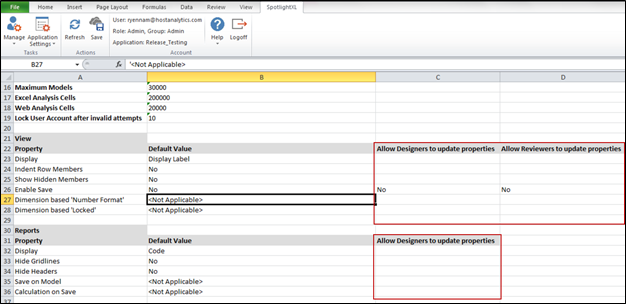
When Zoom in All Level is selected for the Time dimension, yearly, quarterly and monthly data for 2014 and 2015 is displayed as shown below.
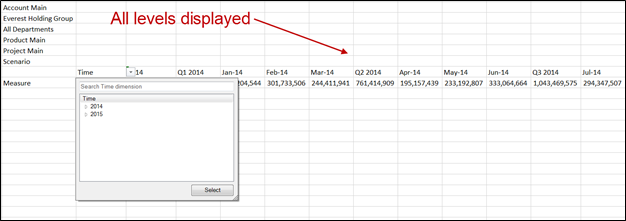
Next Level
When Zoom in Next Level is selected for the Time dimension, only yearly data is displayed as year (2014, 2015) is the next level below the Time dimension.
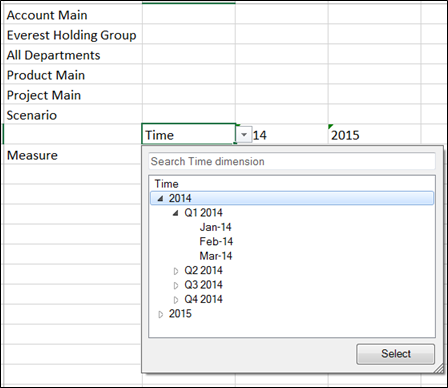
Global Settings for View and Report Properties
With this enhancement, Admin users can set default values for key properties available in Views and Reports. This enhancement provides flexibility for Admin users to define the default behavior from a centralized application page for key properties available in Views and Reports. Admin users can also either allow or restrict Designer and Reviewer users from updating the key properties.
Select the Manage task and the Application Administration, Application Settings subtask.
Defining Default Behavior for View and Report Properties
Under the View and Reports sections, there is a new field called Default Value where you can set default property values for Views and Reports.
For Views, an Admin user can set the default value for Display, Indent Row Members, Show Hidden Members, and Enable Save properties. Default value for Dimension Number Format and Lock properties are not applicable.
For Reports, an Admin user can set the default value for Display, Hide Gridlines, and Hide Headers properties. Default Value for Save on Model and Calculation on Save properties are not applicable.
In the example below, under View, Code is selected for Display Label. That means that for all new Views created from the date and time the setting was saved, all Views will display Code for Display Label. And, under Reports, the Admin user selected No for gridlines and headers, which means that any reports created from the date and tie the setting was saved will not show gridlines and headers.
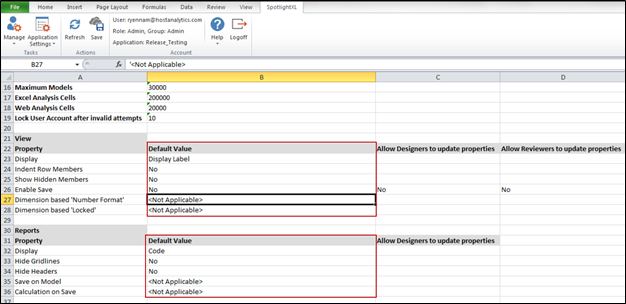
Restricting Designer and Reviewer Users From Updating View and Report Properties
We’ve added new fields called “Allow Designers to Update Properties” and “Allow Reviewers to Update Properties” located under the View and Reports sections.
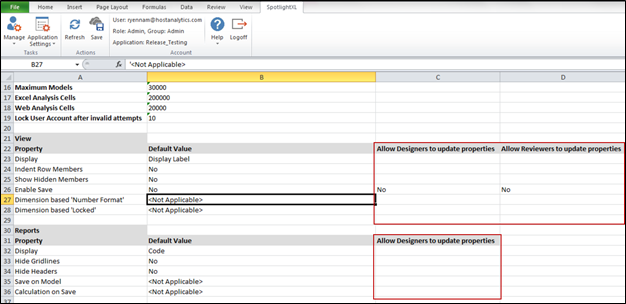
Select properties for Views and Reports that you want to allow or disallow Designer and Review users to update. For example, you might not allow Designer and Reviewer users to update the Display Code for Views. For Reports, Designer users might be able to update the Display Code as well as hide or unhide gridlines and headers.
Additional Scheduler Manager Options
In April, we released Scheduler Manager, which allows you to schedule a Calculation. We are now adding additional scheduling options; weekly and monthly.
Access the Model task and the Calculation subtask. Click the Scheduler Manager action. Select Weekly or Monthly frequencies.
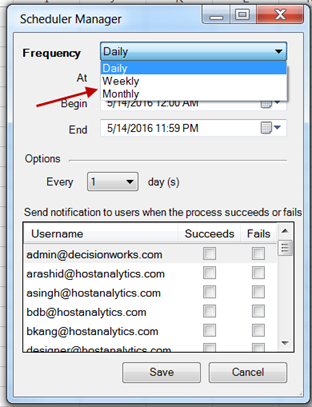
Weekly
When you select the Weekly frequency, the Run on the follow days option is opened. Select each of the days of the week you want the process ran on. In the example below, Sunday and Wednesday is selected.
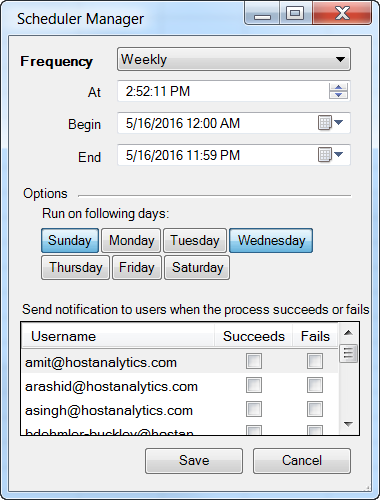
Monthly
When you select the Monthly frequency, the Run on the follow days option is opened. Select each of the days of the month you want the process ran on. In the example below, the 1st and 15th is selected.
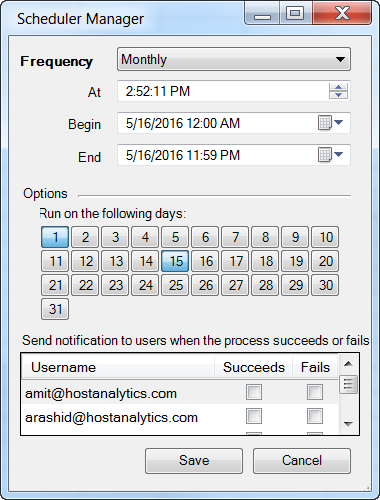
Daily
The Daily frequency has been enhanced so that you can select anywhere from 1 to 31 as shown below.
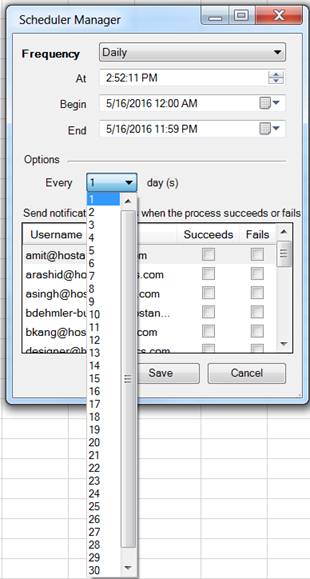
Navigation Access
We’ve added a new level of security to Modeling by allowing Admin users to customize navigation access for Designer users. Select the Manage task and the new Navigation Access subtask.
The Designer role is defaulted, however, in future releases we will be adding the ability to assign navigation access for Reviewers as well.
On the Navigation Access page, each of the fields under Model represent the subtasks. Select Yes to allow users assigned the Designer role to access the subtask. Select No if you do not want Designers to access the subtask. In the example below, Designer users will have access to Model Setup and Model Data, but will not have access to Dimension, Map, Scope, Formula, and Calculation.
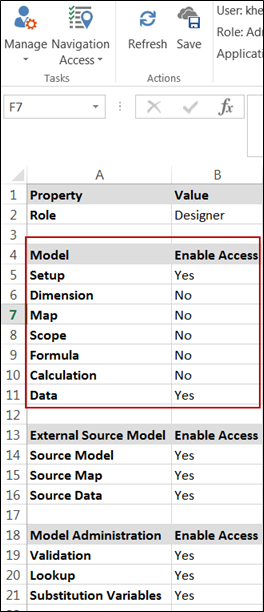
For External Source Model and Model Administration, select the subtasks you want Designer users to access (as you did for the Model subtasks).
Audit Log Enhancements
Access the Audit Log by selecting the Manage task and the Application Administration, Audit Log subtask. The following information is now available for audit:
Views and Reports
Formula, Model
User Login
Integration with Planning, Consolidation, or Reporting Applications
You can access Spotlight (the web version of the Modeling application) directly from Core Applications. If you have Modeling enabled, the following icon in the image below will be displayed in Core Applications. Once you click the Modeling icon, you can opt to open views or reports and Spotlight will launch. No additional sign on is required.
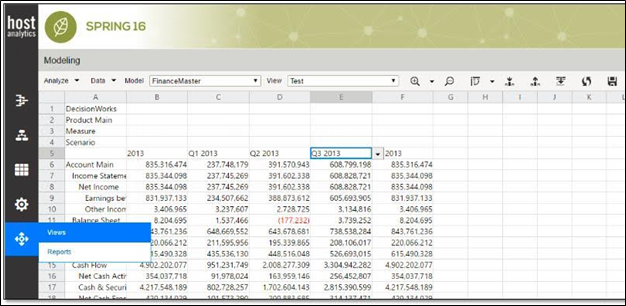
Modern User Interface for Spotlight
We’ve streamlined the Spotlight user interface so that it provides a similar look and feel to the Core applications user interface. All functionality remains the same, but the icons are now grey and the background color has changed to match the color in Core Applications as shown below.
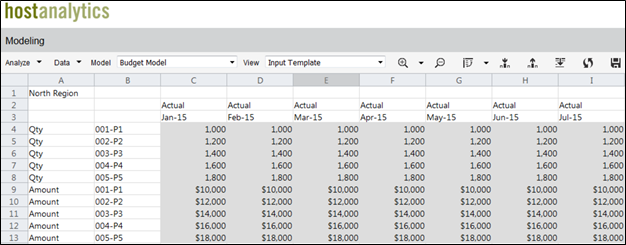
Support for Multiple Rows in Formula Scope When Defining the Formula
You can now have the same dimension listed multiple times with different filters applied. This flexibility allows you to design the formula scope more intricately resulting in even more flexible models for detailed reporting and analysis.
Select the Model task and the Formula subtask. In the example below, the Time dimension is listed twice. The filter is FixedMember for each and set to Q1 2015 and Q2 2015. This means that this model will be built with Time dimension data for these two quarters only.
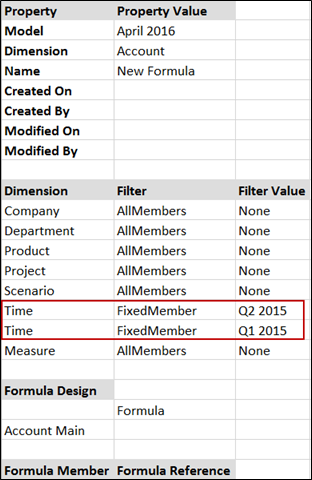
Another example is provided below where, in addition to Time, the Department dimension is filtered so that data from the Product Departments and all members below will be included in the model along with the Design Depts and all members below that dimension.
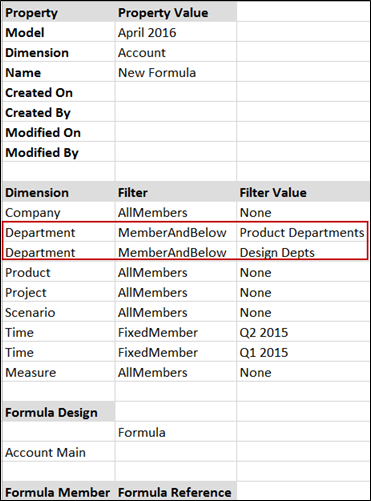
Streamlined Data download and Member Formulas Updates
Data Download
The Data Download application page that was located under the Manage task has been removed as data download should be ran within the Calculation as shown on the Calculation page below. This update eliminates extra set up pages.
Member Formulas
We’ve removed the Member Formulas page, which was located under the Manage task. Member Formulas functionality is now available within the Model task and the Model Administration, Validation subtask (as shown below). The functionality remains the same.
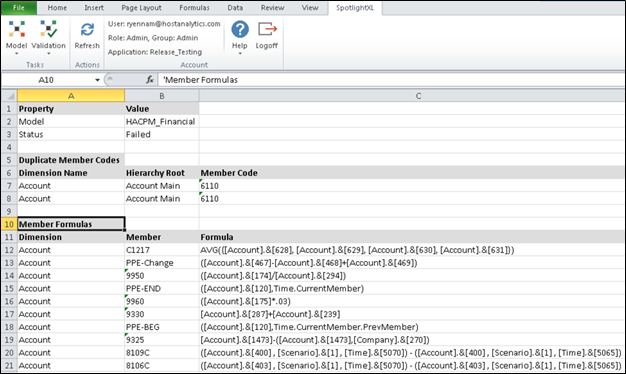
Saving Report Print Range with Report Definition
This feature allows you to save a print area for a report along with the report definition (for example, properties and security). So, for example, let’s say you have a report like the one shown below and you only want to report on data for the Cost Center Departments and Direct Sales.
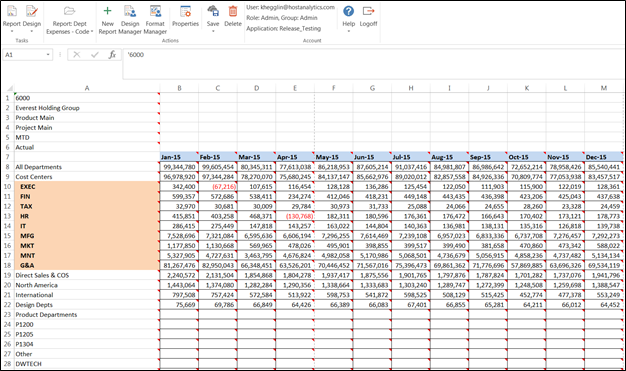
Select the print area and save it as shown below. Now your report will have all data including the report definition with the exception of data below row 20.
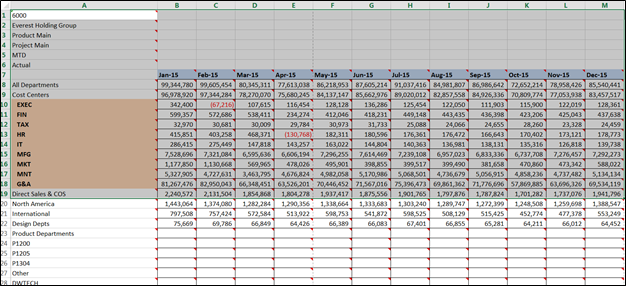
Additional Enhancements
Formula Reference Manager is now enabled by default for all existing and new applications. There is no need to reach out to support team to enable this feature.
We have added a tool tip for items under Favorites and Recent folders. This tool tip displays Model information.
Master / Analytic Model - Append Dimension Members API
Append Member
Use this API to add new members into an existing dimension
The model should already be generated and the dimension should exist
POST /modeling/model/member/append HTTP/1.1
Content-Type: application/xml
Accept: application/xml
X-ACCESS-TOKEN:
<?xml version="1.0" encoding="UTF-8" standalone="yes"?>
<append-member-payload>
<model-name>$ModelName</model-name>
<dimension-name>$DimensionName</dimension-name>
<delimiter>$Delimiter</delimiter>
<hierarchy>$ParentChildHierarchyPlusOperator</hierarchy>
<dimension-member>$DimensionMemberPlusOperator</dimension-member>
… add more dimension members if needed
</append-member-payload>4.5.1 Parameters
$ModelName: (type: string) Name of the model
$DimensionName: (type: string) Name of the calculation to run
$Delimiter: (type: string) Delimiter String
$ParentChildHierarchyPlusOperator: Specify the location of the child member, parent member and rollup operator delimited by delimiter string
DimensionMemberPlusOperator: Specify the new dimension member, its parent and rollup operator delimited by delimiter string in the same order as specified in the hierarchy tag.
Add multiple dimension members using different dimension-member tags.
4.5.2 Sample Payload
<?xml version="1.0" encoding="UTF-8" standalone="yes"?>
<append-member-payload>
<model-name>Operating Expense</model-name>
<dimension-name>Account</dimension-name>
<delimiter>@@</delimiter>
<hierarchy>parent@@child@@operator</hierarchy>
<dimension-member>Account@@Income Statement@@~</dimension-member>
<dimension-member>Income Statement@@Income Statement 100@@+</dimension-member>
</append-member-payload>4.5.3 Response
4.4.3.1 Success Response
HTTP/1.1 204 No Content / 200 OK
4.4.3.2 Error Responses
- Service Not Available (Possibly due to maintenance)
HTTP/1.1 404 Not Found
- One or more HTTP headers were missing
- Model/Dimension not found
HTTP/1.1 412 Precondition Failed
- Unauthorized Access (Access key lookup failed)
HTTP/1.1 401 Unauthorized
- Invalid XML (Bad Request)
HTTP/1.1 400 Bad Request
Known Issues
The following table lists known issues for this release.
| Issue ID | Task | Description |
|---|---|---|
687 | Report Run/Design | The Refresh All Open Reports option does not work as designed in all cases. |
405
| Report Design
| In Report Design, specify a dimension to be cascaded. Copy and paste the cascaded member/block in the same column. Select Save and Run The following is displayed 'Cannot find variable '@Cascade' in model...'. Select Refresh and the following is displayed 'Object reference not set to an instance of an object'. Important! The cascaded member must be defined in the same line or above the cascaded block, otherwise the report will not run. |
477 | Report Design | Cell scaling and lock is not functioning as designed for Cascaded reports. |
417
| Report Design
| Excel Accounting Number Format functionality can be applied to a report while in Report Design. Right not this functionality is not working properly. |
733 | Report Design | POV Default filter value is always code (versus label). |
741 | Report Design | Drill through value is always code (versus label). |
765 | Report Design | Exclude POV does not work properly when run for a cascaded report. |

